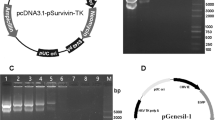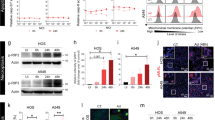Abstract
The efficacy of the suicide gene therapy using the herpes simplex virus thymidine kinase/ganciclovir (HSV-tk/GCV) system for the treatment of cancer is limited because of the insufficient gene transfer and the low killing activity. To enhance the antitumor activity, we determined whether recombinant adenovirus vector (rAd)s expressing both HSV-tk and monocyte chemoattractant protein-1 (MCP-1) genes could potentiate the destruction of hepatocellular carcinoma (HCC). The rAd Ad-tk-MCP1 harboring HSV-tk and MCP-1 genes in sequence under the universal CAG promoter was constructed with a bicistronic unit including the encephalomyocarditis virus-internal ribosomal entry site. The levels of HSV-tk expression and GCV-sensitive tumoricidal activity of Ad-tk-MCP1 were comparable to those of rAd expressing HSV-tk alone. The growth of subcutaneous tumors in athymic nude mice was markedly suppressed when tumors were treated with Ad-tk-MCP1 as opposed to another bicistronic vector Ad-MCP1-tk, rAd expressing either HSV-tk or MCP-1, or both of these vectors. The antitumor effects of Ad-tkMCP1 may be dependent on the activation of macrophages, since the recruitment of macrophages was observed tumor necrosis factor-α production was enhanced in the tumor tissue. Furthermore, the enhanced antitumor effect was abolished by inactivating macrophages with carrageenan treatment. These results demonstrated that a bicistronic rAd harboring both suicide and chemokine genes in sequence exerted the enhanced, macrophage-dependent, antitumor effects in a model of HCC and support the use of this strategy for the treatment of HCC.
This is a preview of subscription content, access via your institution
Access options
Subscribe to this journal
Receive 12 print issues and online access
$259.00 per year
only $21.58 per issue
Buy this article
- Purchase on Springer Link
- Instant access to full article PDF
Prices may be subject to local taxes which are calculated during checkout








Similar content being viewed by others
References
Venook AP . Treatment of hepatocellular carcinoma: too many options? J Clin Oncol. 1994;12:1323–1334.
Trinchet JC, Beaugrand M . Treatment of hepatocellular carcinoma in patients with cirrhosis. J Hepatol. 1997;27:756–765.
Bruix J . Treatment of hepatocellular carcinoma. Hepatology. 1997;25:259–262.
Colombo M . Treatment of hepatocellular carcinoma. J Viral Hepatol. 1997;4:125–130.
Kanai F, Shiratori Y, Yoshida Y, et al. Gene therapy for alpha-fetoprotein-producing human hepatoma cells by adenovirus-mediated transfer of the herpes simplex virus thymidine kinase gene. Hepatology. 1996;23:1359–1368.
Culver KW, Ram Z, Wallbridge S, et al. In vivo gene transfer with retroviral vectro-producer cells for treatment of experimental brain tumors [see comments]. Science. 1992;256:1550–1552.
Kaneko S, Hallenbeck P, Kotani T, et al. Adenovirus-mediated gene therapy of hepatocellular carcinoma using cancer-specific gene expression. Cancer Res. 1995;55:5283–5287.
Cao G, Kuriyama S, Du P, et al. Construction of retroviral vectors to induce strong hepatoma cell-specific expression of cytokine genes. J Gastroenterol Hepatol. 1996;11:1053–1061.
Qin XQ, Tao N, Dergay A, et al. Interferon-beta gene therapy inhibits tumor formation and causes regression of established tumors in immune-deficient mice. Proc Natl Acad Sci USA. 1998;95:14411–14416.
Fricker J . Hepatocellular carcinoma and p53 gene therapy [news]. Mol Med Today. 1996;2:361.
Anderson SC, Johnson DE, Harris MP, et al. p53 gene therapy in a rat model of hepatocellular carcinoma: intra-arterial delivery of a recombinant adenovirus. Clin. Cancer Res. 1998;4:1649–1659.
Bookstein R, Demers W, Gregory R, et al. p53 gene therapy in vivo of herpatocellular and liver metastatic colorectal cancer. Semin Oncol. 1996;23:66–77.
Sakai Y, Kaneko S, Nakamoto Y, et al. Enhanced anti-tumor effects of herpes simplex thymidine kinase/ganciclovir system by codelivering monocyte chemoattractant protein-1 in hepatocellular carcinoma. Carcer Gene Ther. 2001;8:695–704.
Elshami AA, Saavedra A, Zhang H, et al. Gap junctions play a role in the ‘bystander effect’ of the herpes simplex virus thymidine kinase/ganciclovir system in vitro. Gene Ther. 1996;3:85–92.
Kianmanesh AR, Perrin H, Panis Y, et al. A ‘distant’ bystander effect of suicide gene therapy: regression of nontransduced tumors together with a distant transduced tumor. Hum Gene Ther. 1997;8:1807–1814.
Freeman SM, Abbound CN, Whartenby KA et al. The ‘bystander effect’: tumor regression when a fraction of the tumor mass is genetically modified. Cancer Res. 1993;53:5274–5283.
Matsushima K, Larsen CG, DuBois GC, et al. Purification and characterization of a novel monocyte chemotactic and activating factor produced by a human myelomonocytic cell line. J Exp Med. 1989;169:1485–1490.
Sakai Y, Kaneko S, Sato Y, et al. Gene therapy for hepatocellular carcinoma using two recombinant adenovirus vectors with alpha-fetoprotein promoter and Cre/lox P system. J Virol Methods. 2001;92:5–17.
Emerman M, Temin HM . Genes with promoters in retrovirus vectors can be independently suppressed by an epigenetic mechanism. Cell. 1984; 39:459–467.
Cullen BR, Lomedico PT, Ju G . Transcriptional interference in avian retroviruses — implications for the promoter insertion model of leukaemogenesis. Nature. 1984;307:241–245.
Miyake S, Makimura M, Kanegae Y, et al. Efficient generation of recombinant adenoviruses using adenovirus DNA–terminal protein complex and a cosmid bearing the full-length virus genome. Proc Natl Acad Sci USA. 1996;93:1320–1324.
Sato Y, Tanaka K, Lee G, et al. Enhanced and specific gene expression via tissue-specific production of Cre recombinase using adenovirus vector. Biochem Biophys Res Commun. 1998;244:455–462.
Kanegae Y, Makimura M, Saito I . A simple and efficient method for purification of infectious recombinant adenovirus. Jpn J Med Sci Biol. 1994;47:157–166.
Nakabayashi H, Taketa K, Yamane T, et al. Phenotypical stability of a human hepatoma cell line, HuH-7, in long-term culture with chemically defined medium. Gann. 1984;75:151–158.
Ko Y, Mukaida N, Panyutich A, et al. A Sensitive enzyme-linked immunosorbent assay for human interleukin-8. J Immunol Methods, 1992;149:227–235.
Bradford MM . A rapid and sensitive method for the quantitation of microgram quantitation of protein utilizing the principle of protein–dye binding. Anal Biochem. 1976;72:248–254.
Ives DH, Wang SM . Deoxycytidine kinase from calf thymus. In: Hoffe PA, Jones ME, eds Methods Enzymology: Purine and Pyrimidine Nucleotide Metabolism. New York: Academic Press; 1978:337–345.
Ando K, Moriyama T, Guidotti LG, et al. Mechanisms of class I restricted immunopathology. A transgenic mouse model of fulminant hepatitis. J Exp Med. 1993;178:1541–1554.
Suderkoetter C, Steinbrink K, Goebeler R, et al. Macrophage and angiogenesis. J Leukocyte Biol. 1994;55:410–422.
Emerman M, Temin HM . Quantitive analysis of gene suppression in integrated retrovirus vectors. Mol Cell Biol. 1986;6:792–800.
Mizuguchi H, Xu Z, Ishii-Watabe A, et al. IRES-dependent second gene expression is significantly lower than cap-dependent first gene expression in a bicistronic vector. Mol Ther. 2000;4:376–382.
Sharma S, Miller PW, Stolina M, et al. Multicomponent gene therapy vaccines for lung cancer. Effective eradication of established murine tumors in vivo with interleukin-7/herpes simplex thymidine kinase-transduced autologus tumor and ex vivo activated dendritic cells. Gene Ther. 1997;4:1361–1370.
Pizzato M, Franchin E, Calvi P, et al. Production and characterization of a bicistronic Moloney-based retroviral vector expression human interleukin 2 and herpes simplex thymidine kinase for gene therapy of cancer. Gene Ther. 1998;5:1003–1007.
Okada H, Giezaman-Smits KM, Tahara H, et al. Effective cytokine gene therapy against an intracranial glioma using a retrovially transduced IL-4 plus HSVtk tumor vaccine. Gene Ther. 1999;6:219–226.
Okada H, Miyamura K, Iyoh T, et al. Gene therapy against an experimental glioma using adeno-associated virus vectors. Gene Ther. 1996;3:957–964.
Chadha KC, Munyon W . Presence of herpes simplex virus-related antigens in transformed L cells. J Virol. 1975;15: 1475–1486.
Jamieson AT, Macnab JC, Perbal B, et al. Virus specified enzyme activity and RNA species in herpes simplex virus type 1 transformed mouse cells. J Gen Virol. 1976;32:493–508.
Klessig DF, Quinlan MP, Grodzicker T . Proteins containing only half of the coding information of early regions 1b of adenovirus are functional in human cells transformed with the herpes simplex virus type 1 thymidine kinase gene and adenovirus type 2 DNA. J Virol. 1982;41:423–434.
Huang S, Singh RK, Xie K, et al. Expression of the JE/MCP-1 gene suppresses metastatic potential in murine colon carcinoma cells. Cancer Immunol Immunother. 1994;39:231–238.
Rollins BJ, Sunday ME . Suppression of tumor formation in vivo by expression of the JE gene in malignant cells. Mol Cell Biol. 1991;11:3125–3131.
Nokihara H, Yanagawa H, Nishioka Y, et al. Natural killer cell-dependent suppression of systemic spread of human lung adenocarcinoma cells by monocyte chemoattractant protein-1 gene transfection in severe combined immunodeficient mice. Cancer Res. 2000;60:7002–7007.
Nakashima E, Mukaida N, Kubota Y, et al. Human MCAF gene transfer enhances the metastatic capacity of a mouse cachectic adenocarcinoma cell line in vivo. Pharm Res. 1995;12:1598–1604.
Ueno T, Toi M, Saji H, et al. Significance of macrophage chemoattractant protein-1 in macrophage recruitment, angiogenesis, and survival in human breast cancer. Clin Cancer Res. 2000;6:3282–3289.
Nesbit M, Schaider H, Miller TH, et al. Low-level monocyte chemoattractant protein-1 stimulation of monocytes leads to tumor formation in nontumorigenic melanoma cells. J Immunol. 2001;166:6483–6490.
Vile RG, Castleden S, Marshall J, et al. Generation of an anti-tumor immune response in a non-immunogenic tumour: HSVtk killing in vivo stimulates a mononuclear cell infiltrate and a Th1-like profile of intratumoural cytokine expression. Int J Cancer. 1997;71:267–274.
Ramesh R, Marrogi AJ, Munshi A, et al. In vivo analysis of the ‘bystander effect’: a cytokine cascade. Exp Hematol. 1996;24:829–838.
Murray HW, Hariprashad J, Aguero B, et al. Antimicrobial response of a T cell-deficient host to cytokine therapy: effect of interferon-gamma in experimental visceral leishmaniasis in nude mice. J Infect Dis. 1995;171:1309–1316.
Freund CT, Sutton MA, Dang T, et al. Adenovirus-mediated combination suicide and cytokine gene therapy for bladder cancer. Anticancer Res. 2000;20:1359–1366.
Pulkkanen KJ, Parkkinen JJ, Laukkanen JM, et al. HSV-tk gene therapy for human renal cell carcinoma in nude mice. Cancer Gene Ther. 2001;7:529–536.
Sato M, Watanabe Y, Ueda S, et al. Microwave coagulation therapy for hepatocellular carcinoma. Gastroenterology. 1996;110:1507–1514.
Jiao LR . Percutaneous radiofrequency thermal ablation for liver tumours [letter]. Lancet. 1999;354:427–428.
Marshall E . Gene therapy death prompts review of adenovirus vector [news]. Science. 1999;286:2244–2245.
Author information
Authors and Affiliations
Corresponding author
Rights and permissions
About this article
Cite this article
Tsuchiyama, T., Kaneko, S., Nakamoto, Y. et al. Enhanced antitumor effects of a bicistronic adenovirus vector expressing both herpes simplex virus thymidine kinase and monocyte chemoattractant protein-1 against hepatocellular carcinoma. Cancer Gene Ther 10, 260–269 (2003). https://doi.org/10.1038/sj.cgt.7700571
Received:
Published:
Issue Date:
DOI: https://doi.org/10.1038/sj.cgt.7700571
Keywords
This article is cited by
-
Enforced effect of tk-MCP-1 fusion gene in ovarian cancer
Journal of Experimental & Clinical Cancer Research (2012)
-
Membrane-bound form of monocyte chemoattractant protein-1 enhances antitumor effects of suicide gene therapy in a model of hepatocellular carcinoma
Cancer Gene Therapy (2012)
-
Immune Cell Recruitment and Cell-Based System for Cancer Therapy
Pharmaceutical Research (2008)
-
Cellular and molecular events associated with the antitumor response induced by the cytosine deaminase/5-fluorocytosine suicide gene therapy system in a rat liver metastasis model
Cancer Gene Therapy (2007)
-
Gene therapy of liver tumors with human liver-specific nanoparticles
Cancer Gene Therapy (2007)



